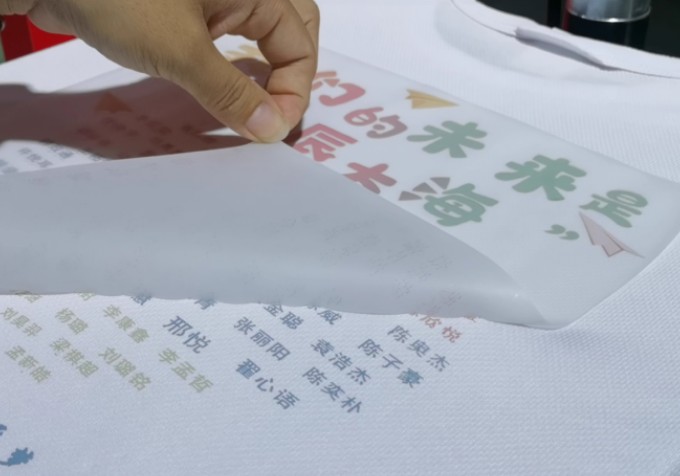This article will provide guidance on how to properly transfer DTF designs onto synthetic fabrics.
Direct-to-Film technology gives TEXTEK users the opportunity to print on textiles with pure synthetic components. These are sportswear fabrics such as sweatshirts and shorts, nylon jackets and gym bags. These can be decorated with DTF designs to produce unique sports fashion garments.
It’s safe to say as far as custom apparel is concerned the cotton black t-shirt reigns supreme. That is what the majority of clients are looking for and they print great! The organic material, especially when you get into the ring-spun variety, are so tightly woven that the fibers are able to lay super flat. Also, because the fabric is not dyed this shade, colors are able to be accurately and consistently represented visually without interference from the actual substrate. But what about dyed materials such as our reds, pinks, oranges? These unnatural colors are dyed to appear as such, and, in turn, can potentially react to decorating that involves high heat. This chemical phenomenon is known as DYE MIGRATION.
What does that mean exactly?
DYE MIGRATION is going to be the movement of a dye from dyed material (such as garment fibers) to another material in contact with the garment - this can include heat transfer vinyl, direct to film transfers, and ink in general, such as silk screen or direct to garment ink. The dye from dyed garments literally sublimates, meaning it will go from a printed, solid state -> change to a gas -> and then re-solidify in the form of dye migration onto your applied graphics. In some instances this can also be seen in the wash where the garment bleeds over time. This would fall into the same category.
Here's a question:
what is dye migration? You've heard of it, maybe you've experienced it. But what exactly is dye migration? How does it affect your garments? Let's talk about how dye migration happens and how you can prevent it from happening on your next work.
 What is dye migration?
What is dye migration?
Dye migration (color migration) is the movement of dye from one dyed material (e.g. T-shirt fabric) to another material (DTF ink) in contact with that dyed material by diffusion at the molecular level. This phenomenon is commonly found in printing processes such as DTF, DTG and screen printing where heat treatment is required.
Due to the sublimation properties of disperse dyes, any fabric dyed with disperse dyes is very susceptible to color migration during the subsequent treatment (e.g. printing, coating, etc.), processing and use of the final product. Essentially, the dye is heated to change from a solid to a gas. In particular, dark fabrics such as T-shirts, swimwear and sportswear are extremely susceptible to color shift due to sublimation when stamping white or light-colored graphics and logos.
This heat-related defect is costly for print manufacturers, especially when dealing with expensive high-performance garments. Severe cases can lead to product scrapping and significant financial losses to the company that are difficult to recover. Taking measures to prevent and predict test dye migration is an important key to achieving good print quality.
To avoid such issues as much as possible, follow these troubleshooting guidelines:
Some DTF printers try to avoid migration by using denser white inks. But the truth is, when you use denser ink, you need longer time and higher temperature to dry it. It just takes longer and ends up getting worse.
All you need is a suitable DTF application solution. The key is to choose DTF ink with anti- hemorrhage and anti-sublimation, so as to avoid dye migration well.
Bleed resistance, or the resistance of the ink to the dye on the garment, is determined by the chemical composition of the ink, the degree of curing of the ink, and the degree of deposition of the ink. The DTF ink provided by TEXTEK has good anti-bleeding property, which effectively solves the problem of color migration in the transfer process. The ink particles are small and stable, and the printing is smooth without clogging the print head. It has passed rigorous testing, is environmentally friendly, has virtually no odor, and requires no special ventilation.
Anti-dye migration DTF hot melt adhesive powder can also build a firewall to isolate the migration channel of single-molecule dyes.
TEXTEK offers you two products, DTF Anti-sublimation white powder and DTF Anti-sublimation black powder. Both products are made from imported high-quality, high-purity raw materials. After curing, they are soft and elastic to the touch and are characterized by high viscosity, washability and abrasion resistance. It is designed to stop color migration on dark fabrics.
TEXTEK's business covers many countries around the world, including emerging markets and mature markets. We have a complete sales system and are committed to using our professional knowledge and first-class service to help customers improve their digital printing business.
.jpg)

.jpg)
